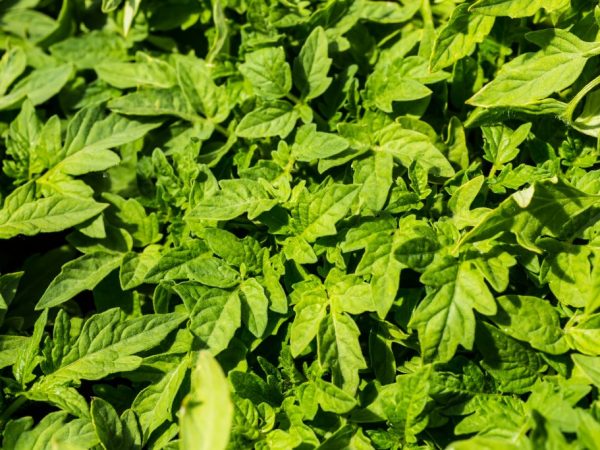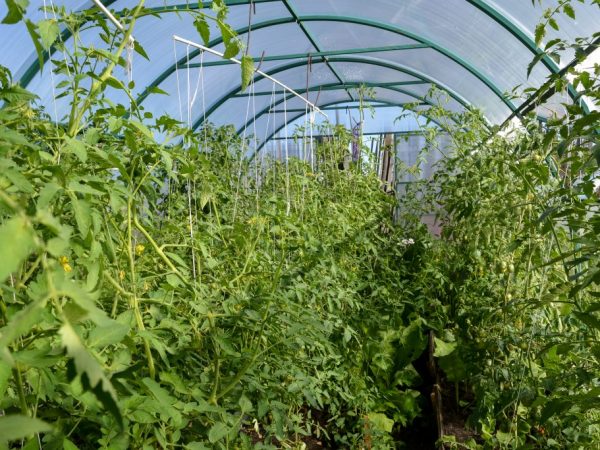Why tomatoes do not bloom in the greenhouse
Tomatoes are far from the most capricious crop grown in greenhouses, but even optimally selected fertilizers, temperature and humidity do not always guarantee proper development and yield. Sometimes the plant stops budding for no apparent reason. Consider why tomatoes do not bloom in a greenhouse, and already formed buds fall off.

Tomatoes do not bloom in the greenhouse
Causes of the phenomenon
To determine the reason for the lack of flowering and understand what to do, you need to consider a number of premises. In most cases, unfavorable growing conditions are the reason.
The main reasons for the lack of budding:
- Low air temperature (optimum temperature - 20-25 °) or soil. With a lack of heat, the seedlings not only stop forming buds, but also die.
- Excess heat in the air (over 30 ° C).
- Excess or lack of moisture in the soil or air.
- Lack of pollination. In greenhouse conditions, tomatoes must be artificially pollinated.
You can determine whether a plant is comfortable in these conditions by its appearance. If a bush has overly massive stems and leaves in the absence of flowers, it experiences a lack of heat. Lack of moisture can be easily identified by noticing cracked soil at the roots, twisted yellowed leaves, and dry tops.
In addition to the main factors that can stop the budding of tomatoes, there are also additional ones:
- lack of lighting and air circulation due to thickening of planting cuttings;
- deficiency of potassium or phosphorus with a lack of fertilizers;
- oversaturation with nitrogen with an overabundance of organic fertilizers (manure, compost);
- various diseases;
- treatment of seedlings with pesticides.
Sometimes the plant simply does not have the strength to form buds. Multiple and large-fruited tomatoes are susceptible to this. In such varieties, it is recommended to control the number of ovaries. It is better to choose tomatoes with medium fruits. They are less susceptible to ovary shedding.
Care errors
It happens that the absence of flowering or the falling off of the formed buds on tomatoes is due not only to external factors. Due to the lack of experience or the necessary information, the gardeners themselves can do what negatively affects the budding of the culture.
The most common mistakes made are:
- growing certain varieties from their own planting material (seeds): such tomatoes will not bear fruit;
- pesticide treatment of bushes that are already in bloom:
- mistakenly chosen location of the greenhouse in relation to access to sunlight (lack of heat);
- excessively dense planting of plants, in which they interfere with each other's normal growth and development.
Tatiana Orlova (Candidate of Agricultural Sciences):
For cultivation in greenhouses, plants are mainly used with high intensity of growth and productivity. These are usually first generation hybrids, designated on the package as F1. Leaving the fruits from these plants on the seeds is not worth it, becauseduring hybridization, plants with different biological properties could be used. In the second generation, these seeds can give a negative result, you can get a powerful plant, but with small fruits of poor quality and almost no flowering.
If you correctly and timely establish the reason why new flowers do not form on the tomato, but the already formed ones fall off, you can choose effective measures to restore the budding of tomatoes.
Prevention methods

Tomatoes need to create good conditions.
After establishing the cause of the growth retardation of the plant, it must be immediately eliminated. The sooner favorable conditions for the seedling are restored, the more chances for normal growth and development of the plant.
To restore comfortable conditions it is necessary:
- Set a suitable temperature in the greenhouse (heaters should be used during frosts).
- Water the paths between the seedlings with cool water to increase the humidity of the air and reduce the temperature. This should be done before noon to avoid condensation.
- Water the plants with warm water to raise the temperature by a couple of degrees (only if the temperature outside is not more than 15 ° C).
- Ventilate greenhouses from time to time to get fresh air.
- To carry out artificial pollination or to lure bees by placing honey-bearing flowers in the greenhouse.
- Get rid of all the wastelands so that the seedling can devote its energies to the formation of new buds.
When watering a plant, you should always pay attention to the water temperature. If it is too low, the roots of the plant will be stressed and the budding process will stop.
Tomato is a culture sensitive to fungal diseases, therefore, before planting, it is imperative to disinfect the seeds (with a manganese solution) and the soil (with steam, heating, or with a manganese solution). When a bush is infected with a fungus or insects, it is necessary to start fighting them immediately.
Tatiana Orlova (Candidate of Agricultural Sciences):
One of the simplest ways to disinfect soil in a greenhouse - thermal - is spilling boiling water. Immediately after this, the soil in the greenhouse is covered with a tarp so that it does not cool down quickly. This makes it possible in the spring not only to disinfect the top layer of the soil, but also to warm it up in order to start planting work earlier.
Prophylaxis
To prevent problems with budding, regular preventive measures should be taken. Their timeliness can greatly reduce the risk of damage to seedlings.
First of all, in order to prevent the loss of flowers in tomatoes, the culture must be cared for on time.
There are several rules to follow:
- Do not create an excess of nitrogen fertilizers in the soil when the tomatoes are blooming.
- Before flowering, fertilize the soil with double superphosphate and potassium sulfate.
- Monitor the humidity of the air: 60% is ideal in the greenhouse.
- Adhere to a slight temperature fluctuation in the range of 20-25 ° C.
- Water flowering bushes abundantly at the root twice a week
- Loosen the soil periodically for better air circulation.
The most important principles of prevention are methodical and timely implementation, as well as adherence to all recommendations.
The choice of planting material
To minimize the risk of plant damage, you need to know the rules for preparing planting material, caring for the plant and creating optimal conditions for crop growth.
When buying seeds for greenhouse cultivation, you need to pay attention to their quality, as well as the expiration dates indicated on the package. Old planting material can cause poor budding and flower fall.
Conclusion
Color falls from tomato seedlings in a greenhouse for various reasons, ranging from external negative factors to gardeners' mistakes.However, all these problems can be corrected if the cause is identified and eliminated in a timely manner.
To minimize the risk, it is recommended to plant several varieties of tomatoes that differ in their resistance to high or low temperatures. In this case, even in the absence of ovaries on one of the species, one can count on obtaining a crop of another variety.



